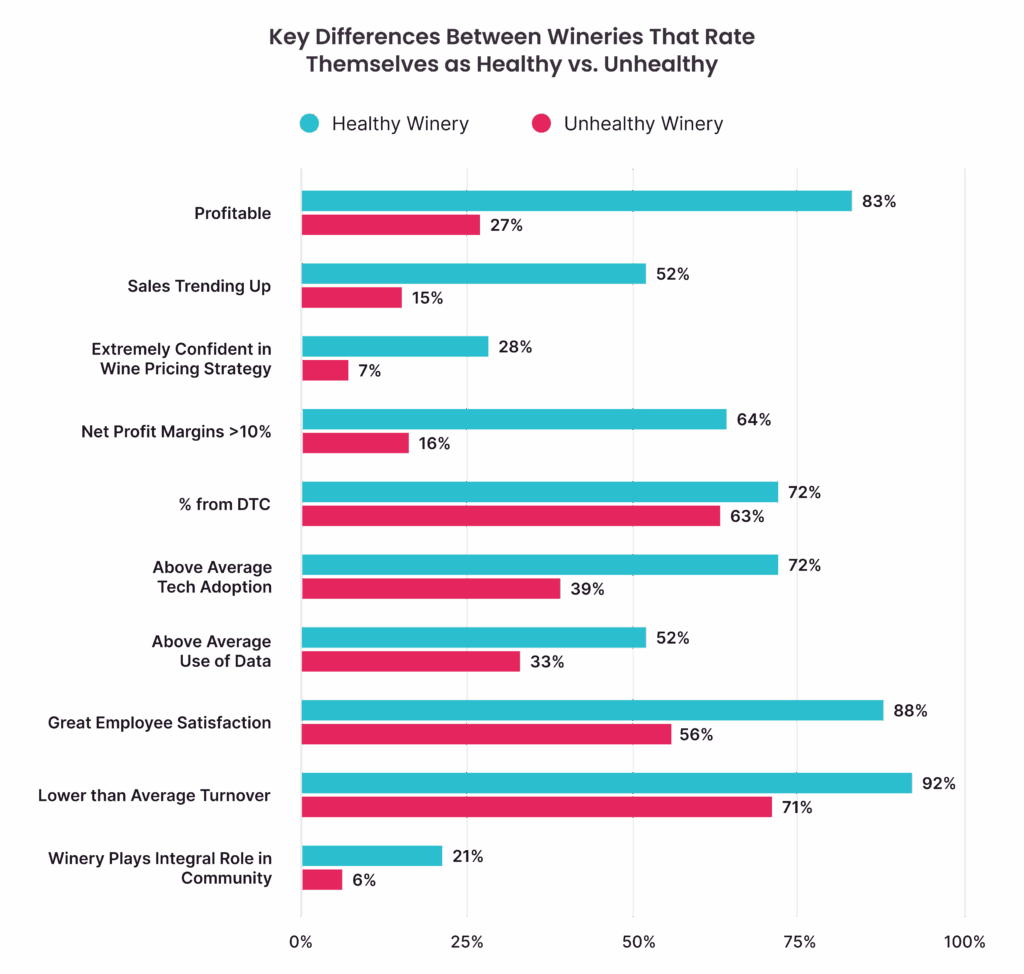Winery health isn’t defined by one metric. It’s a reflection of how well a winery performs across three key dimensions: financial resilience, operational excellence, and cultural strength.
Every year, InnoVint surveys hundreds of winery professionals to understand what truly drives a healthy winery. In the 2025 State of Winery Health Report, our statistical analysis confirmed that all three dimensions matter, but financial performance stands out as the clearest signal of overall business health. Profitability, sales growth, and pricing confidence consistently separate the strongest wineries from those struggling to keep pace.
But the story doesn’t end there. Operational practices, technology adoption, and team culture all play vital roles in supporting long-term success.
What Does “Winery Health” Mean in 2025?
At its core, winery health represents a winery’s ability to stay profitable, efficient, and resilient — even as the industry faces rising costs and shifting consumer demand.
Healthy wineries aren’t just surviving. They’re forward-thinking, data-driven, and connected to their people and communities. They know their numbers, run disciplined operations, and foster cultures that retain talent and inspire collaboration.
Let’s break down each dimension and what the data shows.
Financial Health: The Strongest Indicator of Winery Health
What Financial Health for a Winery Means
Financial health reflects a winery’s profitability, cash flow stability, and pricing confidence. In other words, how effectively the business turns grapes into sustainable profit. Most wineries know their sales volume, but financial health goes beyond that. It’s about knowing your profit margins, tracking cost of goods sold (COGS) accurately, and making pricing decisions rooted in data, not instinct.
Healthy financials give wineries the freedom to plan for the future, weather downturns, and make smarter operational decisions.
What the Data Shows
The 2025 State of Winery Health Report found financial metrics to be the most reliable predictor of overall health:
- Profitability matters. Wineries with a 20–30% net profit margin rated their health as excellent or good 63% of the time, compared to just 26% for those with margins below 10%.
- Sales growth plays a role. 67% of wineries with increasing sales rated their health positively, compared to only 17% of those with declining sales.
- Pricing confidence is key. Nearly 64% of wineries extremely confident in their pricing strategy rated their overall health as excellent or good.
In fact, financial indicators alone explain over 60% of the variation in overall winery health ratings.
Operational Health: Why Efficiency Still Matters
What Operational Health for a Winery Means
Operational health captures how efficiently a winery runs — from vineyard management and production to collaboration, technology, and data use. Healthy operations mean clear processes, aligned teams, modern systems, and visibility across departments. A well-run winery can adapt quickly, reduce waste, and make informed decisions in real time. And they have systems to ensure alignment between supply and demand.
An operationally healthy winery runs like a well-tuned machine: teams are aligned, data is centralized, and decisions are made quickly and confidently.
What the Data Shows
While financial factors may be the clearest predictor of health, operational strength magnifies those gains. According to the State of Winery Health Report:
- Wineries with excellent operations were 3x more collaborative and 4x more confident in pricing.
- Technology adoption is a defining factor. 65% of high-tech wineries reported strong health, compared to only 14% of low adopters.
- Data-driven decision-making drives better outcomes. 70% of data-forward wineries rated their business as excellent or good, versus 22% of those lagging behind.
These findings reinforce that modern operations improve sales, satisfaction, and long-term sustainability.
Cultural Health: The Human Side of a Healthy Winery
What Cultural Health for a Winery Means
Cultural health measures the human side of winery success — employee satisfaction, leadership alignment, and community connection. A healthy winery culture is one where teams feel valued, communication is open, and the winery sees itself as part of a larger ecosystem, not just a business.
What the Data Shows
Culture, people, and community involvement may be harder to quantify, but their impact on overall wine business health is undeniable.
- Employee satisfaction matters! Wineries with high employee satisfaction rated their health positively 68% of the time, compared to just 20% among those with dissatisfied teams.
- Community involvement strengthens business health. Wineries considered integral to their local community were 3x more likely to be profitable and 3x more likely to report increasing sales.
- Workforce stability was linked to better outcomes. Low-turnover wineries reported stronger health ratings than high-turnover businesses.
A positive culture, both internally and within the community, fuels retention, strengthens collaboration, and drives profitability.
The Complete Picture of Winery Health
Financial performance may be the most visible driver, but the healthiest wineries understand that profitability is an outcome — not the goal itself. Sales growth, profitability, and pricing confidence are made possible by well-run operations, smart use of technology, and teams that are motivated and connected to their communities.
Wineries that invest in all three — financial, operational, and cultural health — position themselves to thrive no matter what the market brings.

Want to See How Your Winery Compares?
Get the full 2025 State of Winery Health Report, featuring data and insights from over 500 winery professionals.